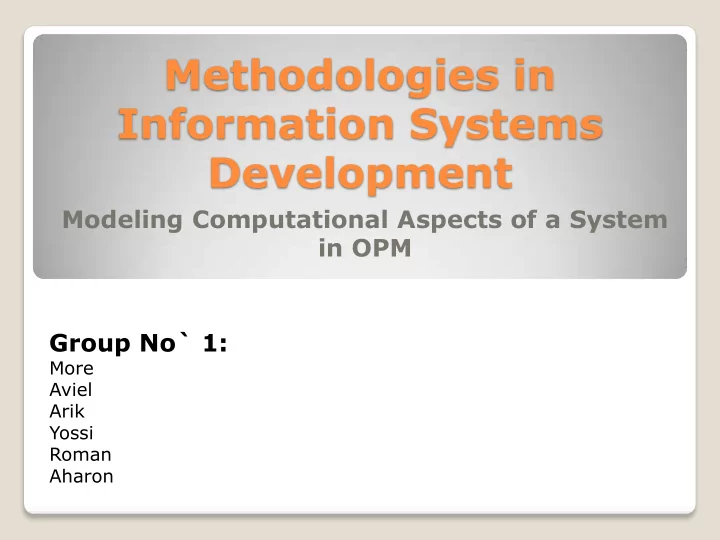

Methodologies in Information Systems Development Modeling Computational Aspects of a System in OPM Group No` 1: More Aviel Arik Yossi Roman Aharon
Motivation Some computational scenarios are not well defined in OPM. This causes a lack of consistency and makes it difficult to use OPM modeling for developing software. We created models, based on the correct OPM semantics according to “Operational Semantics for OPM” by Valeria Perelman. They could be used as templates in OPCAT.
While Loop – Our Solution
Why is Control-Flow important? The standard OPM model conceptually captures the system’s behavior (along with it’s structure) A concrete representation of behavior is not fully existent in the OPM model. For this matter, a parallel representation of the model is being developed, called OPM Matlab Layer (OPM\ML).
In order to correctly replace an OPD representation with a OPM\ML representation (and vice versa) it is necessary to define a single accurate representation for Control-Flow processes. It is vital that the model representation is compatible with the true OPM semantics, in order to maintain the compatibility between the model and the OPM\ML, which is created by those semantics
The Parallel Representation
While Loop – Count to 3 example Build in Initialized to 3 The user needs to connect
While Loop – Count to 3 example
While Loop – Count to 3 example Decrease integer by 1 in each iteration How do we know when the effect takes place?
While Loop – Alternative 1 What is the order of the state changing? a a b b c c When procedural links that originate from an entity are labeled, the one that Not Scalable! must be followed is the one whose label is identical with the label of the procedural link that arrives at the entity.
While Loop – Alternative 2 In the process iteration, the context of the process already exists and is reused, thus all the local objects of the process instance preserve their state from the previous run
While Loop – Alternative 3 The process can get stuck because of the wait until mechanism Requirement link instead of checking condition Wait until means that the triggered process checks the preprocess object set.
Skip / Wait until If Pre-Process Conditions Fail The process waits untill they If Pre-Process Conditions Fail become true The process is skipped
While Loop – Alternative 4 C Sub process outside the in-zooming ellipse isn’t Part of the time flow and needs to be invoked C by the process’s internal events
Other Points of Interest Referencing Processes • A sub process can be referenced using the ” ref:path ” role, with a path to the process definition. • All the objects linked to the referenced process must match the types defined for the process. • If there are several links of the same type, they should be distinguished by different tag “roles” (divisor and dividend) • When running in an enclosed process, the ref process uses the parents’ local variables. If not, it uses global context of the system.
Example – Recursion
Other Points of Interest Constraint Processes A Constraint process is re-activated in an infinite loop during the life time of the thing it’s bounded to by the characterization link.
Conclusions Even given elaborate semantics, there are many different ways of modeling systems. While it is important to allow flexibility in modeling systems, It is essential that fundamental aspects of software be consistent and build in within OPCAT. There needs to be a golden path in allowing both flexibility and conformity.
Thank You
Recommend
More recommend